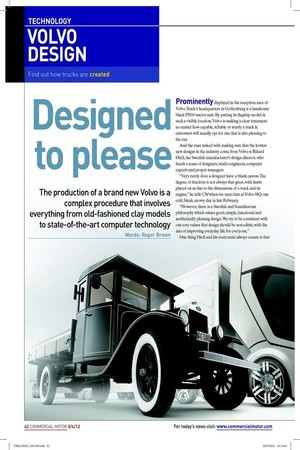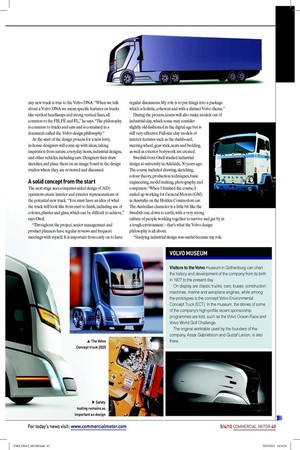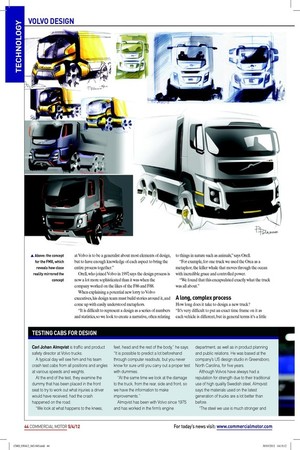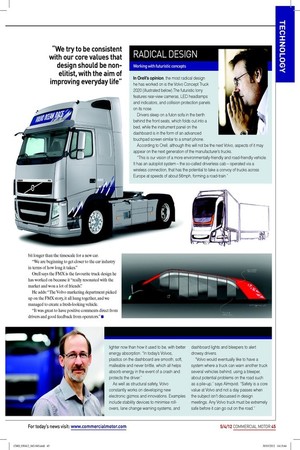Designed to please
Page 34

Page 35

Page 36

Page 37

If you've noticed an error in this article please click here to report it so we can fix it.
TECHNOLOGY
VOLVO DESIGN
Find out how trucks are created
The production of a brand new Volvo is a complex procedure that involves everything from old-fashioned clay models to state-of-the-art computer technology
Words: Roger Brown Prominently displayed in the reception area of Volvo Truck’s headquarters in Gothenburg is a handsome black FH16 tractor unit. By putting its lagship model in such a visible location, Volvo is making a clear statement: no matter how capable, reliable or sturdy a truck is, customers will usually opt for one that is also pleasing to the eye.
And the man tasked with making sure that the hottest new designs in the industry come from Volvo is Rikard Orell, the Swedish manufacturer’s design director, who heads a team of designers, studio engineers, computer experts and project managers.
“Very rarely does a designer have a blank canvas. The degree of freedom is not always that great, with limits placed on us due to the dimensions of a truck and its engine,” he tells CM when we meet him at Volvo HQ one cold, bleak, snowy day in late February.
“However, there is a Swedish and Scandinavian philosophy which values good, simple, functional and aesthetically pleasing design. We try to be consistent with our core values that design should be non-elitist, with the aim of improving everyday life for everyone.” One thing Orell and his team must always ensure is that any new truck is true to the Volvo DNA. “When we talk about a Volvo DNA we mean speciic features on trucks like vertical headlamps and strong vertical lines, all common to the FH, FE and FL,” he says. “The philosophy is common to trucks and cars and is contained in a document called the Volvo design philosophy.” At the start of the design process for a new lorry, in-house designers will come up with ideas, taking inspiration from nature, everyday items, industrial designs, and other vehicles, including cars. Designers then draw sketches, and place them on an image board in the design studios where they are reviewed and discussed.
A solid concept from the start
The next stage sees computer-aided design (CAD) operators create interior and exterior representations of the potential new truck. “You must have an idea of what the truck will look like from start to inish, including use of colours, plastics and glass, which can be dificult to achieve,” says Orell.
“Throughout the project, senior management and product planners have regular reviews and frequent meetings with myself. It is important from early on to have regular discussions. My role is to put things into a package which is holistic, coherent and with a distinct Volvo theme.” During the process, teams will also make models out of industrial clay, which some may consider slightly old-fashioned in the digital age but is still very effective. Full-size clay models of interior features such as the dashboard, steering wheel, gear stick, seats and bedding, as well as exterior bodywork are created.
Swedish-born Orell studied industrial design at university in Adelaide, 30 years ago. The course included drawing, sketching, colour theory, production techniques, basic engineering, model making, photography and computers. “When I inished the course, I ended up working for General Motors (GM) in Australia on the Holden Commodore car. The Australian character is a little bit like the Swedish one, down to earth, with a very strong culture of people working together to survive and get by in a tough environment – that’s what the Volvo design philosophy is all about.
“Studying industrial design was useful because my role at Volvo is to be a generalist about most elements of design, but to have enough knowledge of each aspect to bring the entire process together.” Orell, who joined Volvo in 1997, says the design process is now a lot more sophisticated than it was when the company worked on the likes of the F86 and F88.
When explaining a potential new lorry to Volvo executives, his design team must build stories around it, and come up with easily understood metaphors.
“It is dificult to represent a design as a series of numbers and statistics, so we look to create a narrative, often relating to things in nature such as animals,” says Orell.
“For example, for one truck we used the Orca as a metaphor, the killer whale that moves through the ocean with incredible grace and controlled power.
“We found that this encapsulated exactly what the truck was all about.”
A long, complex process
How long does it take to design a new truck?
“It’s very dificult to put an exact time frame on it as each vehicle is different, but in general terms it’s a little bit longer than the timescale for a new car.
“We are beginning to get closer to the car industry in terms of how long it takes.” Orell says the FMX is the favourite truck design he has worked on because it “really resonated with the market and won a lot of friends”.
He adds: “The Volvo marketing department picked up on the FMX story, it all hung together, and we managed to create a fresh-looking vehicle.
“It was great to have positive comments direct from drivers and good feedback from operators.” ■
RADICAL DESIGN
Working with futuristic concepts
In Orell’s opinion, the most radical design
he has worked on is the Volvo Concept Truck 2020 (illustrated below).The futuristic lorry features rear-view cameras, LED headlamps and indicators, and collision protection panels on its nose.
Drivers sleep on a futon sofa in the berth behind the front seats, which folds out into a bed, while the instrument panel on the dashboard is in the form of an advanced touchpad screen similar to a smart phone.
According to Orell, although this will not be the next Volvo, aspects of it may appear on the next generation of the manufacturer’s trucks.
“This is our vision of a more environmentally-friendly and road-friendly vehicle.
It has an autopilot system – the so-called driverless cab – operated via a wireless connection, that has the potential to take a convoy of trucks across Europe at speeds of about 56mph, forming a road-train.”
TESTING CABS FOR DESIGN
Carl Johan Almqvist is traffic and product safety director at Volvo trucks.
A typical day will see him and his team crash test cabs from all positions and angles at various speeds and weights.
At the end of the test, they examine the dummy that has been placed in the front seat to try to work out what injuries a driver would have received, had the crash happened on the road.
“We look at what happens to the knees, feet, head and the rest of the body,” he says. “It is possible to predict a lot beforehand through computer readouts, but you never know for sure until you carry out a proper test with dummies.
“At the same time we look at the damage to the truck, from the rear, side and front, so we have the information to make improvements.” Almqvist has been with Volvo since 1975 and has worked in the firm’s engine department, as well as in product planning and public relations. He was based at the company’s US design studio in Greensboro, North Carolina, for five years.
Although Volvos have always had a reputation for strength due to their traditional use of high quality Swedish steel, Almqvist says the materials used on the latest generation of trucks are a lot better than before.
“The steel we use is much stronger and lighter now than how it used to be, with better energy absorption. “In today’s Volvos, plastics on the dashboard are smooth, soft, malleable and never brittle, which all helps absorb energy in the event of a crash and protects the driver.” As well as structural safety, Volvo constantly works on developing new electronic gizmos and innovations. Examples include stability devices to minimise rollovers, lane change warning systems, and dashboard lights and bleepers to alert drowsy drivers.
“Volvo would eventually like to have a system where a truck can warn another truck several vehicles behind, using a bleeper, about potential problems on the road such as a pile-up,” says Almqvist. “Safety is a core value at Volvo and not a day passes when the subject isn’t discussed in design meetings. Any Volvo truck must be extremely safe before it can go out on the road.”
VOLVO MUSEUM
Visitors to the Volvo museum in Gothenburg can chart the history and development of the company from its birth in 1927 to the present day.
On display are classic trucks, cars, buses, construction machines, marine and aeroplane engines, while among the prototypes is the concept Volvo Environmental Concept Truck (ECT). In the museum, the stories of some of the company’s high-profile recent sponsorship programmes are told, such as the Volvo Ocean Race and Volvo World Golf Challenge.
The original worktable used by the founders of the company, Assar Gabrielsson and Gustaf Larson, is also there.











































